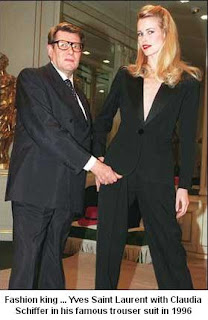Vietnamese designer Pham Nguyen Hoang Thien Toan’s
collection was inspired by traditional values and the bamboo.
When Asian motifs cross-fertilise with Western styles at a Berlin fashion fair, the results can be a rather weird, yet appetising, new dish.
IT wasn’t quite Zhang ZiYi’s memorable dance from Memoirs of a Geisha. But the opening geisha dance to kick off InFashion during the Asia-Pacific Week 2007 in Berlin clearly hinted at the exotic appeal of the east.
For three days in late autumn last year, Kosmos, a preserved cinema along Karl-Marx Allee in former East Berlin was turned into a fashion catwalk.
For the first time during a German fashion fair, 20 promising fashion designers from China, Korea, Japan, Malaysia, Indonesia, Singapore, Vietnam and Thailand were invited to showcase their work in Berlin. There was a clear exchange of influences, in line with InFashion’s goal of highlighting how Asian and Berlin fashion designers were inspiring each other.
Rather than focusing on successful Asian designers such as Tokyo-born Rei Kawakubo (who has 300 Comme des Garcons stores worldwide) or Korean-American Doo-ri Chung (proclaimed as among the most talented of the new generation of designers) the organisers wanted only fresh, unknown designers.
Chinese designers dominated the catwalk, as there were eight of them out of the invited 20. Some of the parades down the catwalk were such a mad mix of styles they became a spectacle for the wrong reasons.
There were extravagant Oriental inspired flows of Chinese silks in lavish gowns worthy to be showcased in Curse of the Golden Flower. Shanghai designer Qu Tingnan combined extravagant Chinese embroidery with the pomposity of European ball gowns.
Then there was Beijing designer Chu Yan whose frothy layers of silk were draped over sequined swimwear-like apparel. There was even a stuffed baby panda perched over the shoulder of a Scottish Highland-inspired checked kilt. Strange? Yes. Inspiring? No.
InFashion was organised by Berlin-based company Fashion Patrons and supported by fashion school Esmod Germany and The House of World Cultures. Since early last year, a search was launched to find promising fashion designers from Asia Pacific.
“Through the Goethe Institutes in Asian cities, we received 150 applications. We chose 20 designers whom we believe represent the new fashion face of Asia,” explained Fashion Patron director Klaus Metz to Asian Pacific journalists attending the event.
“Each designer had to have a series of 50 completed outfits and have two years in their respective markets. Creativity was vital. Asia has a vibrant explosion of growth as of late. I am convinced that Europe and Asia will have more mutual influences in future especially in the creative industries. Technology and travel will further propagate this.”
“A fashion designer stands out from the masses when they have a very personal view of creativity and life. Fashion should deeply interest you to a high level of passion. Only with profound experience and confidence can a designer be different.”
He added that it would not have been financially possible for a young designer just starting their career to introduce a collection to European markets.
“We hope this helps them get a foothold into the market.”
Mysterious Malaysian
Malaysia was represented by Chee Au. Haven’t heard of her? Well, neither have we! The Malaccan-born designer is refreshingly media-shy, and keeps an unusually low profile.
Born the fifth of seven girls, Chee’s parents constantly kept them busy with sketchbooks and colouring pencils. At seven years, Chee was sewing wedding gowns for her Barbie doll inspired by Princess Diana’s 1981 royal wedding.
She enrolled at the famed Parsons School of Design in New York (the same school that had produced designers like Zang Toi) and majored in fashion design. Roped into Kenzo upon graduation, Chee worked with renowned designers including Oscar de la Renta, Donna Karan, Anne Klein and Nicole Miller. In 2005, she launched her self-named label in Hong Kong, which is her current base.
Till today, Chee Au is unknown in Malaysia despite having opened a Paris boutique. She refuses to have any publicity, not even a phone or email interview with us as she was attending a conference during InFashion.
“To Chee Au, it’s about the clothes, not about the designer, as is the current popular scenario in the fashion world,” insisted Daniel Henry, Chee Au’s fashion stylist who represented her in Berlin.
”Her clothes are about playing with construction and contrasts. It’s about quality workmanship in luxury fabrics. There are a lot of Asian elements as a tribute to Chee Au’s homeland. She had luxurious wool cashmere pieces lined with understated silk cotton. Strong lines and triangular shapes inspired by traditional Malaysian songket designs are applied to soft, feminine silhouettes.
“The theme for Berlin was Mysterious. The pieces accentuate the female form. Lots of cotton and silks were used and we played on the concept of smocking.”
But for Pham Nguyen Hoang Thien Toan, one of Vietnam’s foremost young designers, traditional values were an important thread running through his modern urban design style, which was themed Tre or Bamboo.
Models sashayed down the catwalk twirling conical woven grass hats that contrasted with dresses of organza, taffeta, linen and silk featuring traditional Vietnamese embroidery.
“My designs represent true Vietnamese values, my people and the countryside,” he said.
“Bamboo symbolises Vietnamese values of bravery and determination. Padi fields are also a frequent inspiration in my clothes because they awaken a strong sense of space and shape.
There are often embroideries with rice motifs and the sun. I hope I can introduce some of Vietnam’s beautiful landscapes and our indomitable spirit through my designs.”



